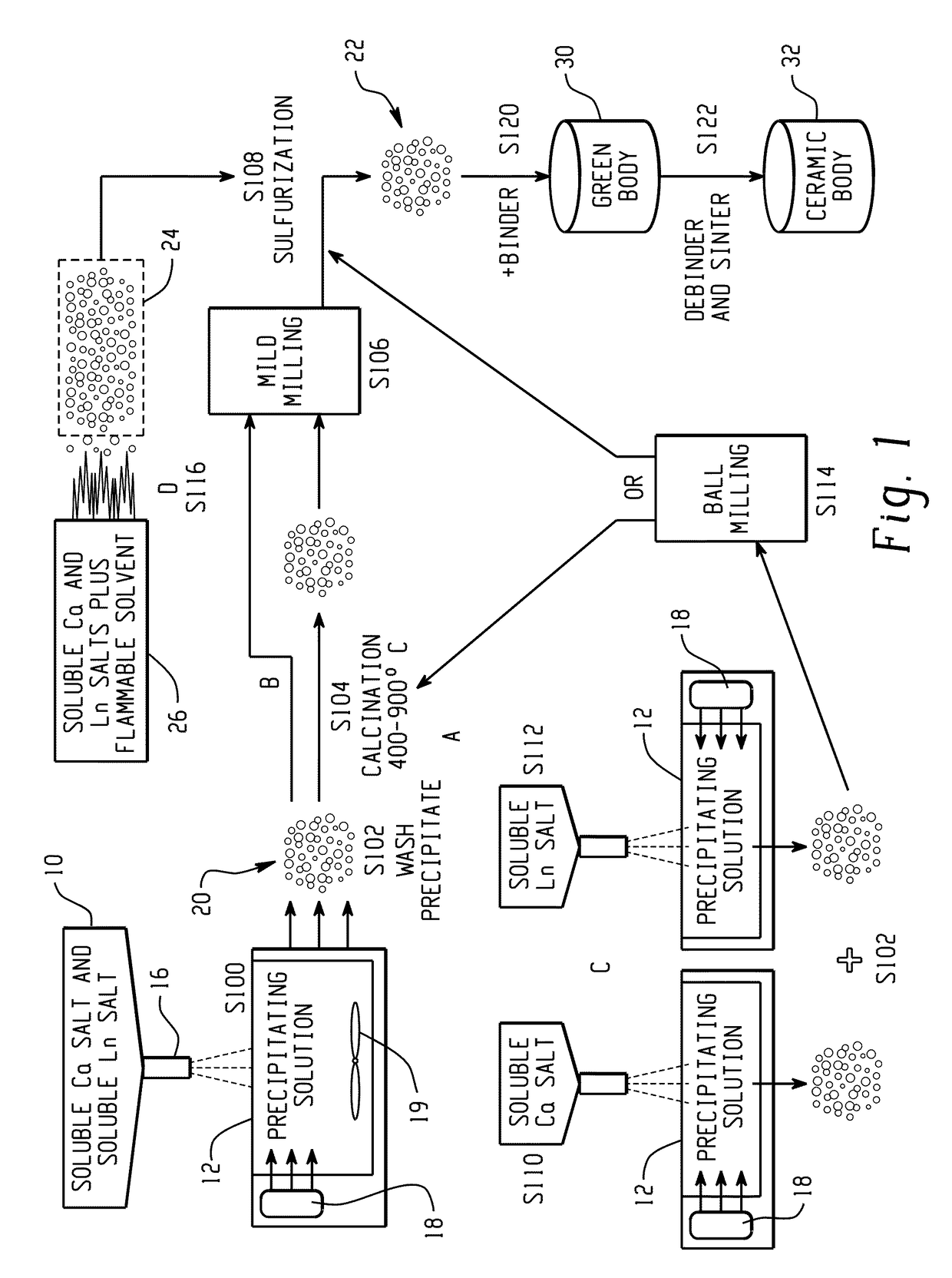Calcium lanthanoid sulfide powders, methods of making, and ceramic bodies formed therefrom
a technology of lanthanoid sulfide and powder, which is applied in the field of lanthanoid sulfide powder, methods of making, and ceramic bodies formed therefrom, and can solve the problems of poor environmental weatherability, high absorption coefficient, and material limitations,
- Summary
- Abstract
- Description
- Claims
- Application Information
AI Technical Summary
Benefits of technology
Problems solved by technology
Method used
Image
Examples
example 1
Formation of CLS Nanopowder by Co-Precipitation
[0053]A mixed solution of calcium nitrate and lanthanum nitrate (Ca2+ / La3+=1:2) was prepared in DI water by combining 0.1 mol. calcium nitrate and 0.2 mol lanthanum nitrate) and heated in a beaker. Fine droplets (1-20 μm) of the nitrate solution were sprayed, using an ultrasonic atomizer (Sonics & Materials Inc., model VC-134), into a warm (50° C.) ammonium bicarbonate water solution (1 mol) at a constant rate under vigorous stirring and with ultrasonication (Branson model B-3510DTH ultrasonic bath at about 20 kHz). Stirring of the reaction mixture was continued for an additional hour after addition of the nitrate solution.
[0054]The cooled mixture was filtered and washed with DI water. The wet precursor cake was transferred to a beaker containing aprotic solvent (acetone) as a washing agent and the mixture was stirred or sonicated until a major portion of water was replaced with the washing agent. The washing with the aprotic solvent wa...
example 2
Formation of CLS Nanopowder by Co-Precipitation
[0061]A procedure of Example 1 can be used except that the mixed solution of calcium nitrate and lanthanum nitrate (Ca2+ / La3+=1:2) is dropped into a warm ammonium oxalate solution to precipitate calcium and lanthanum oxalate. The rest of the procedure can be as for Example 1.
example 3
Formation of CLS Nanopowder by Separate Precipitation
[0062]The procedure of Example 1 can used except that separate solutions of calcium nitrate and lanthanum nitrate were separately precipitated into ammonium oxalate. This example is similar to Example 2 with the difference that calcium and lanthanum oxalates are precipitated separately. Fine particles of calcium oxalate are precipitated at a pH of about 4 and fine powders of lanthanum oxalate are precipitated at a pH of about 1.
[0063]The calcium and lanthanum oxalate nanopowders formed are then mixed in 1:2 molar ratio of Ca:La and ball milled together using ZrO2 grinding media in ethanol for 6 hours. After ball milling, the powder slurry is separated from the grinding media and centrifuged to separate ethanol from the powder. After removing the ethanol, the powder is dried in an oven for 48 hrs. The mixed oxalate powder is then calcined at a temperature between 400° C. and 900° C. to burn off carbon. In cases where soft agglomera...
PUM
| Property | Measurement | Unit |
|---|---|---|
| temperature | aaaaa | aaaaa |
| size | aaaaa | aaaaa |
| particle size | aaaaa | aaaaa |
Abstract
Description
Claims
Application Information
 Login to View More
Login to View More - R&D
- Intellectual Property
- Life Sciences
- Materials
- Tech Scout
- Unparalleled Data Quality
- Higher Quality Content
- 60% Fewer Hallucinations
Browse by: Latest US Patents, China's latest patents, Technical Efficacy Thesaurus, Application Domain, Technology Topic, Popular Technical Reports.
© 2025 PatSnap. All rights reserved.Legal|Privacy policy|Modern Slavery Act Transparency Statement|Sitemap|About US| Contact US: help@patsnap.com



